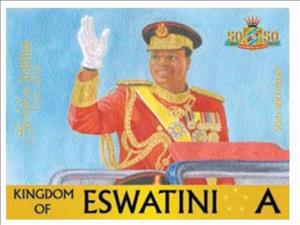Stamp: 50th Anniversary of Independence (Swaziland 2018)
50th Anniversary of Independence (Swaziland 2018)
31 August (Swaziland ) within release 50th Anniversary of Independence goes into circulation Stamp 50th Anniversary of Independence face value A No Face Value
| Stamp 50th Anniversary of Independence in catalogues | |
|---|---|
| Colnect codes: | Col: SZ 2018-01A |
Stamp is square format.
Swaziland renamied iteself eSwatini in early 2018. All future issues will bear the name "eSwatiini" rather than Swaziland.Also in the issue 50th Anniversary of Independence:
- Stamp - 50th Anniversary of Independence face value A;
- Stamp - 50th Anniversary of Independence face value D;
- Stamp - 50th Anniversary of Independence face value C;
- Stamp - 50th Anniversary of Independence face value B;
|
Data entry completed
50%
|
|
|---|---|
| Stamp 50th Anniversary of Independence in digits | |
| Country: | Swaziland |
| Date: | 2018-08-31 |
| Emission: | Commemorative |
| Format: | Stamp |
| Face Value: | A No Face Value |
Stamp 50th Anniversary of Independence it reflects the thematic directions:
An anniversary is the date on which an event took place or an institution was founded in a previous year, and may also refer to the commemoration or celebration of that event. For example, the first event is the initial occurrence or, if planned, the inaugural of the event. One year later would be the first anniversary of that event. The word was first used for Catholic feasts to commemorate saints. Most countries celebrate national anniversaries, typically called national days. These could be the date of independence of the nation or the adoption of a new constitution or form of government. The important dates in a sitting monarch's reign may also be commemorated, an event often referred to as a "Jubilee".
King is the title given to a male monarch in a variety of contexts. The female equivalent is queen regnant (while the title of queen on its own usually refers to the consort of a king). In the context of prehistory, antiquity and contemporary indigenous peoples, the title may refer to tribal kingship. Germanic kingship is cognate with Indo-European traditions of tribal rulership (c.f. Indic rājan, Gothic reiks, and Old Irish rí, etc.) In the context of classical antiquity, king may translate Latin rex or either Greek archon or basileus. In classical European feudalism, the title of king as the ruler of a kingdom is understood as the highest rank in the feudal order, potentially subject, at least nominally, only to an emperor (harking back to the client kings of the Roman Empire). In a modern context, the title may refer to the ruler of one of a number of modern monarchies (either absolute or constitutional). The title of king is used alongside other titles for monarchs, in the West prince, emperor, archduke, duke or grand duke, in the Middle East sultan or emir; etc. Kings, like other royalty, tend to wear purple because purple was an expensive color to wear in the past.
A Royalty is the immediate family of a king or queen regnant, and sometimes his or her extended family. The term imperial family appropriately describes the family of an emperor or empress, and the term papal family describes the family of a pope, while the terms baronial family, comital family, ducal family, grand ducal family, or princely family are more appropriate to describe the relatives of a reigning baron, count, duke, grand duke, or prince. However, in common parlance members of any family which reigns by hereditary right are often referred to as royalty or "royals." It is also customary in some circles to refer to the extended relations of a deposed monarch and his or her descendants as a royal family. A dynasty is sometimes referred to as "the House of ...". As of July 2013, there are 26 active sovereign monarchies in the world who rule or reign over 43 countries in all



